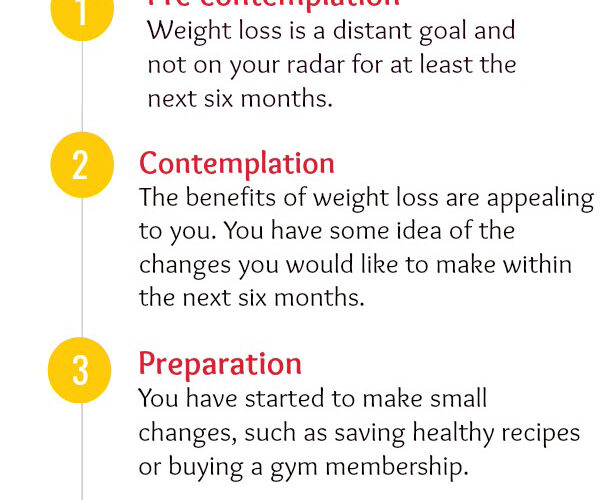Start by setting realistic goals and creating a balanced diet plan. Incorporate regular exercise and track your progress.
Embarking on a weight loss journey requires careful planning and dedication. Setting achievable goals helps maintain motivation and ensures sustainable progress. A balanced diet, rich in nutrients, lays the foundation for effective weight management. Regular physical activity, tailored to your fitness level, accelerates fat loss and improves overall health.
Monitoring your progress allows for adjustments and keeps you accountable. Consulting with a healthcare professional can provide personalized guidance. Staying hydrated and getting adequate sleep are also crucial. A positive mindset and support from friends or family can make the journey more enjoyable and successful.

Credit: www.india.com
Embarking On A Weight Loss Journey
Starting a weight loss journey can be exciting and challenging. Proper preparation is key for success. This guide will help you begin.
Setting Realistic Goals
Setting realistic goals is crucial for your weight loss journey. Unrealistic goals can lead to frustration and giving up. Instead, aim for achievable milestones.
- Be Specific: Define clear, specific goals like losing 2 pounds a week.
- Measurable: Track progress with a journal or app.
- Achievable: Ensure goals are realistic for your lifestyle.
- Relevant: Goals should align with your overall health objectives.
- Time-bound: Set a deadline to keep yourself on track.
Assessing Your Current Lifestyle
Understanding your current habits is essential. Identify areas needing change. This assessment helps in creating a practical plan.
| Current Habit | Suggested Change |
|---|---|
| Skipping Breakfast | Start your day with a healthy meal. |
| Eating Late at Night | Finish eating 2-3 hours before bed. |
| Low Physical Activity | Incorporate daily exercise like walking or yoga. |
Small changes can make a big impact. Begin by modifying one habit at a time.
Nutrition Fundamentals
Understanding nutrition is key to a successful weight loss journey. Proper nutrition fuels your body, aids in fat loss, and keeps you healthy. Let’s dive into the basics of macronutrients and micronutrients.
Understanding Macronutrients
Macronutrients are nutrients your body needs in large amounts. They include proteins, fats, and carbohydrates. Each plays a vital role in your body:
- Proteins: Build and repair tissues, and support muscle growth. Good sources are chicken, fish, beans, and tofu.
- Fats: Provide energy and support cell growth. Healthy fats include avocados, nuts, and olive oil.
- Carbohydrates: Main energy source. Opt for whole grains, fruits, and vegetables.
Balancing these macronutrients helps in maintaining energy levels and promoting fat loss.
The Role Of Micronutrients
Micronutrients are vitamins and minerals needed in smaller quantities. They are crucial for overall health and well-being. Important micronutrients include:
- Vitamin D: Supports bone health and immune function. Sources: sunlight, fatty fish, and fortified milk.
- Iron: Essential for blood production. Sources: red meat, spinach, and lentils.
- Calcium: Needed for strong bones and teeth. Sources: dairy products, leafy greens, and almonds.
Including a variety of fruits and vegetables in your diet ensures you get these essential micronutrients.
Creating A Balanced Diet Plan
Starting a weight loss journey can be both exciting and challenging. One essential step is creating a balanced diet plan. A well-rounded diet helps you lose weight and stay healthy. Below are some vital aspects to consider.
Portion Control
Portion control is crucial for losing weight. Eating smaller portions helps you consume fewer calories. Use smaller plates to trick your mind into feeling satisfied with less food. Make sure each meal includes a mix of proteins, carbs, and fats. This balance keeps you full and nourished.
| Food Group | Recommended Portion Size |
|---|---|
| Proteins | 3-4 ounces (size of a deck of cards) |
| Carbohydrates | 1/2 cup (size of a tennis ball) |
| Fats | 1 tablespoon (size of a thumb) |
Incorporating Variety
A diverse diet keeps meals interesting and ensures you get all nutrients. Try to incorporate different food groups in your diet. Aim to eat a rainbow of fruits and vegetables. Each color provides unique vitamins and minerals.
- Red foods: Tomatoes, strawberries, red bell peppers
- Green foods: Spinach, broccoli, green beans
- Yellow foods: Corn, yellow bell peppers, bananas
Variety also prevents boredom, making it easier to stick to your diet. Change your protein sources regularly. Include chicken, fish, tofu, and legumes. Experiment with different whole grains like quinoa, brown rice, and oats.
Importance Of Hydration
Starting a weight loss journey can be exciting. One key factor often overlooked is hydration. Staying hydrated plays a crucial role in achieving your weight loss goals. Let’s dive into why hydration is important.
Water Intake
Water is essential for life. It helps your body function properly. Drinking enough water supports your weight loss efforts. Aim to drink at least 8 glasses of water daily.
- Carry a reusable water bottle.
- Set reminders to drink water.
- Include water-rich foods like fruits and vegetables.
Drinking water before meals can help you eat less. It fills your stomach, making you feel fuller. This can reduce your calorie intake.
Effects On Metabolism
Hydration impacts your metabolism. Metabolism is the process of converting food into energy. Staying hydrated helps your body burn calories more efficiently.
- Water helps break down food.
- It aids in nutrient absorption.
- Proper hydration boosts energy levels.
Cold water can increase your metabolism. Your body uses energy to warm it up. This can help you burn a few extra calories.
Hydration also supports muscle function. Well-hydrated muscles work better during exercise. This can enhance your workout performance and help you lose weight faster.
Make hydration a priority in your weight loss journey. It’s a simple yet powerful tool.
Exercise Strategies For Weight Loss
Starting a weight loss journey can be overwhelming. Effective exercise strategies can help. Knowing how to exercise can make your journey smoother. Let’s explore the best exercise strategies for weight loss.
Cardio Vs. Strength Training
Cardio exercises are great for burning calories. Activities like running, cycling, or swimming fall into this category. Cardio increases your heart rate and helps burn fat. It’s an effective way to lose weight.
Strength training builds muscle and boosts metabolism. Lifting weights or bodyweight exercises like push-ups are examples. More muscle mass means you burn more calories even at rest. Strength training is essential for long-term weight loss.
Both types of exercises are beneficial. Combining cardio and strength training can maximize results. Balance your workouts to include both for optimal weight loss.
Consistency Over Intensity
Many people start with intense workouts. This can lead to burnout. It’s better to be consistent with moderate exercise.
Regular exercise, even in small amounts, yields better results. Aim for at least 30 minutes of activity most days of the week. Gradually increase intensity as you get stronger.
Consistency builds a habit. A steady routine helps you stay on track. Choose activities you enjoy to maintain consistency. This makes it easier to stick with your exercise plan.
| Exercise Type | Benefits |
|---|---|
| Cardio | Burns calories, improves heart health |
| Strength Training | Builds muscle, boosts metabolism |
Remember, the key is to keep moving. Find a balance that works for you. Stay consistent for the best weight loss results.

Credit: info.iowaradiology.com
Behavioral Changes For Success
Starting a weight loss journey requires more than just diet and exercise. Behavioral changes are essential for long-term success. Adopting new habits can make the journey smoother and more enjoyable. Let’s explore two key areas: Mindful Eating and Coping with Cravings.
Mindful Eating
Mindful eating involves paying full attention to your food. This practice helps you enjoy meals and recognize hunger and fullness signals. Here are some tips:
- Chew slowly and savor each bite.
- Turn off distractions like TV and phones during meals.
- Focus on the taste, texture, and aroma of your food.
- Eat at a designated place, like a dining table.
- Listen to your body’s hunger and fullness cues.
Mindful eating helps control portion sizes and prevent overeating. Practice it daily for better results.
Coping With Cravings
Cravings are a common hurdle in any weight loss journey. Managing them effectively is crucial. Use these strategies:
- Identify triggers: Know what causes your cravings.
- Keep healthy snacks, like fruits and nuts, on hand.
- Stay hydrated; sometimes thirst is mistaken for hunger.
- Distract yourself with activities like walking or reading.
- Practice portion control; have a small amount to satisfy the craving.
Understanding and managing cravings can help you stay on track. Make these strategies part of your routine.
| Behavioral Change | Action Steps |
|---|---|
| Mindful Eating |
|
| Coping with Cravings |
|
Monitoring Progress
Monitoring progress is essential on your weight loss journey. It helps you stay motivated and adjust strategies. By keeping track of your diet and body changes, you can see what works best for you.
Tracking Your Diet
Tracking your diet ensures you stay on course. Use a food diary or a mobile app to record everything you eat. This helps identify eating patterns and areas for improvement.
- Write down all meals and snacks.
- Note portion sizes.
- Include calorie counts.
- Track water intake.
Using a table can make tracking easier:
| Meal | Food Items | Portion Size | Calories |
|---|---|---|---|
| Breakfast | Oatmeal, Banana | 1 cup, 1 | 150, 90 |
| Lunch | Grilled Chicken Salad | 2 cups | 350 |
| Dinner | Steamed Veggies, Quinoa | 1 cup, 1 cup | 200, 220 |
Measuring Body Changes
Measuring body changes helps you see your progress. Use a scale and a measuring tape to track weight and body measurements.
- Weigh yourself weekly at the same time.
- Measure waist, hips, and arms monthly.
- Take progress photos every month.
Record measurements in a table for easy comparison:
| Date | Weight | Waist | Hips | Arms |
|---|---|---|---|---|
| Week 1 | 150 lbs | 34 inches | 40 inches | 12 inches |
| Week 4 | 145 lbs | 33 inches | 39 inches | 11.5 inches |
Consistency is key. Monitor progress regularly and adjust your plan as needed.
Overcoming Plateaus And Setbacks
Weight loss journeys often face plateaus and setbacks. These phases can feel discouraging. But with the right strategies, you can overcome them. This section will guide you through adjusting your plan and staying motivated.
Adjusting Your Plan
When you hit a plateau, it’s time to reassess your plan. Sometimes, your body needs a change to keep losing weight. Consider these adjustments:
- Change your workout routine.
- Mix up your diet with new healthy foods.
- Increase your daily activity levels.
Track your progress with a food diary or fitness app. This helps identify areas needing improvement. Also, ensure you are getting enough sleep and managing stress. Both can impact your weight loss journey.
Staying Motivated
Staying motivated is crucial during setbacks. Here are some tips:
- Set short-term goals. Celebrate small victories.
- Find a workout buddy. Support each other.
- Reward yourself with non-food treats.
Create a vision board with your goals and achievements. This visual reminder keeps you focused. Also, join online communities for support and inspiration. Share your progress and learn from others.
Remember, setbacks are part of the journey. Stay positive and keep moving forward.
Support Systems And Communities
Embarking on a weight loss journey can feel overwhelming. A strong support system can make all the difference. Connecting with others can help you stay motivated and accountable. Let’s explore how to find and leverage support networks and communities.
Finding A Support Network
Start by identifying your closest circle. Friends, family, or colleagues can offer tremendous support. Share your goals and ask for their encouragement.
Local fitness groups are another great option. Many communities have walking clubs, yoga classes, or gym groups. These groups often welcome new members, creating a sense of belonging.
| Support Network | Description |
|---|---|
| Friends and Family | Share your goals and seek their encouragement |
| Local Fitness Groups | Join community clubs or classes for a sense of belonging |
Leveraging Social Accountability
Social accountability can boost your weight loss journey. Share your progress on social media platforms. This can provide a sense of accomplishment and keep you on track.
Joining online communities or forums can also help. Websites dedicated to fitness and weight loss offer support and advice. You can share your experiences and get feedback from others.
Consider using apps that track your progress. Many apps allow you to connect with friends and share your achievements. This can create a healthy competitive spirit and motivate you further.
- Share progress on social media
- Join online fitness communities
- Use apps for tracking and sharing

Credit: stayfitmom.com
Preparing For Long-term Success
Embarking on a weight loss journey requires more than just short-term effort. To achieve lasting results, you need to focus on sustainable habits. This approach will help you avoid the pitfalls of yo-yo dieting. Let’s explore how you can set yourself up for long-term success.
Sustainable Habits
Building sustainable habits is crucial for long-term weight loss success. Quick fixes may give instant results, but they are often short-lived. Instead, focus on creating habits that you can maintain.
- Healthy Eating: Choose nutrient-dense foods over empty calories.
- Regular Exercise: Incorporate both cardio and strength training.
- Hydration: Drink plenty of water throughout the day.
- Sleep: Aim for 7-9 hours of quality sleep each night.
Consistency is key. Small, consistent actions lead to lasting changes. Track your progress to stay motivated. Use a journal or app to monitor your habits.
Avoiding Yo-yo Dieting
Yo-yo dieting can be detrimental to your health. It involves losing and regaining weight repeatedly. This cycle can lead to frustration and poor health outcomes.
| Yo-Yo Dieting | Long-Term Success |
|---|---|
| Short-term focus | Long-term habits |
| Extreme calorie restrictions | Moderate, balanced intake |
| Quick results | Steady progress |
| Frequent weight fluctuations | Stable weight maintenance |
To avoid yo-yo dieting, set realistic goals. Aim to lose 1-2 pounds per week. This pace is healthy and sustainable. Celebrate small victories to stay motivated.
Seek support from friends, family, or a professional. A support system can provide encouragement and accountability. Join a community or find a workout buddy.
Remember, your weight loss journey is a marathon, not a sprint. Focus on the journey, not just the destination. Sustainable habits and avoiding yo-yo dieting will lead to long-term success.
Frequently Asked Questions
What To Do Before Starting Weight Loss Journey?
Consult a doctor for a health check-up. Set realistic and achievable goals. Plan a balanced diet with a nutritionist. Start a regular exercise routine. Track your progress and stay motivated.
What Is The 30/30/30 Rule For Weight Loss?
The 30/30/30 rule for weight loss involves 30% diet, 30% exercise, and 30% behavioral changes. It promotes balanced weight management.
How Do I Start A Consistent Weight Loss Journey?
Start by setting realistic goals. Create a balanced diet plan. Exercise regularly, combining cardio and strength training. Track your progress. Stay consistent and patient.
How To Lose 50 Pounds In 3 Months?
To lose 50 pounds in 3 months, follow a strict diet and exercise plan. Eat balanced meals, avoid processed foods, and control portions. Engage in regular cardio and strength training. Stay hydrated and get enough sleep. Consult a doctor before starting any weight loss program.
Conclusion
Embarking on a weight loss journey requires careful planning and dedication. Set realistic goals and stay consistent. Prioritize a balanced diet and regular exercise. Seek support from friends or professionals. Remember, small changes lead to big results. Start today and embrace a healthier, happier you.


